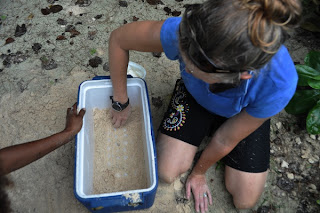We currently have two marine biologists staying with us at Lissenung. Daniel Godoy is from New Zealand and is the only turtle researcher over there, so it was great to have him here. Ian is also from New Zealand, but is currently completing his PhD in marine biology at James Cook University in Townsville. He researches the impacts of climate change on the connectivity of reef fish populations in PNG. Both are partly sponsored by Lissenung Island Resort in that they are being charged a nominal amount for accommodation, meals and diving.
Dan offered to hold a presentation about turtles at the Enuk Community School on 10 August. Turtles are declining drastically in numbers, and PNG is one of only a few places in the Pacific that still has a reasonable population of these critically endangered species. However, Papua New Guineans eat both the turtle and her eggs, commercial fishing is substantial and rubbish often gets thrown in the ocean. Time to educate the kids so hopefully, their generation will look after turtles more!!
The kids were very interested and listened intently. Dan did a great job, keeping the talk in easy-to-understand English as the kids only learn English in grade 5. Lots of questions were asked and answered, and we even had a turtle drawing competition, with the first three winners getting a small prize.
 |
| Daniel explaining about turtles to the kids at Enuk Community School |
Lythia, the teacher, as well as 6 student teachers from the Port Moresby Teachers College, who are on their practical at Enuk, were also engrossed in the subject. Lythia wrote down a lot of points on the blackboard so they could discuss more later.
Next week, we'll have the kids over at Lissenung for a snorkelling session, should be great fun!
 |
| Building a human leatherback turtle so the kids get an idea about just how big they are |
As we were getting closer to Ral Island, we could see a banana boat and some local people on the beach. Ian joked "Haha, they are probably taking eggs now!". Unfortunately, he was right, the people had collected approx. 100 eggs from a fresh nest. Bugger, we were about 10 - 15 minutes too late to rescue these eggs!!!
 |
Tracks of a Green Turtle at Ral Island. You can just see
Ian's toes at the bottom of the pic, so you get an idea of how big the tracks are. |
 |
| Me digging a new nest on Lissenung Island |
 |
If the egg is turned, the embryo may become detached
from the shell, and with that, the air supply to the
embryo is interrupted. It's a bit like your reg coming
loose from your dive tank....
|
 |
| One by one, the eggs are placed into their new nest, under the watchful eye of Chivas |
 |
| "Mum, are you doing that properly??" |
 |
| 31 turtle eggs in their new nest |
 |
| "Awesome, 31 more turtles to swim with from my beach!!" |









